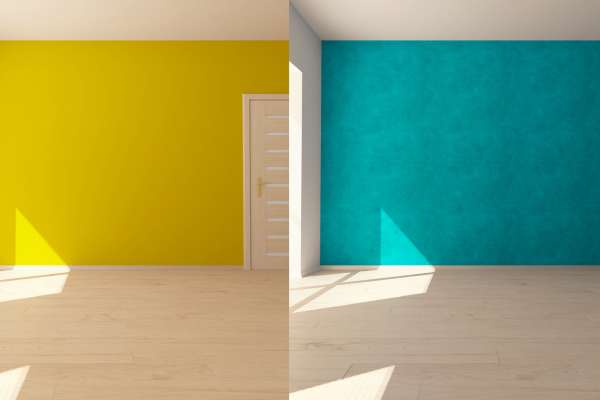Painting An accent wall is the perfect way to achieve this without committing to repainting an entire room. Whether you’re A seasoned painter or new to the world of DIY projects, This article will guide you through the step-by-step process of creating A stunning accent wall that will transform any room in your home. In this comprehensive guide, We will discuss everything from choosing the right color And location for your accent wall to prepping the surface And applying paint with precision. We understand that painting can sometimes feel overwhelming, But fear not! With our easy-to-follow instructions and helpful tips, You’ll be able to tackle this project with confidence And achieve professional-looking results.
What Is An Accent Wall?
An accent wall, Also known as A feature wall, Is A wall in A room that stands out from the rest, Often due to its distinctive color, Pattern, Or texture. It’s A popular interior design choice intended to draw the eye and inject personality into A space. Accent walls provide an opportunity to experiment with bold colors or designs that might overwhelm if applied to an entire room. They’re often the focal point of A space, Enhancing the room’s existing features And defining Its aesthetic.
Do I Need To Prime My Wall Before Painting?
Priming your wall before painting is an important preparation step that should not be overlooked. Primer serves as A base coat, Allowing for smoother application of the paint, Enhancing its adhesion and durability, and helping to conceal the wall’s original color or any imperfections. If you’re planning to paint A lighter color over A darker one, Or if your wall has stains or is made of porous materials like drywall, Priming is crucial. Although it adds a step to the process, Priming can save you time And resources in the long run by reducing the number of paint coats required.
How Long Should I Wait Between Coats Of Paint?
The wait time between paint coats can vary based on the type of paint used and the environmental conditions in your painting space. Generally, Latex or acrylic paints require A minimum of two to four hours of drying time between coats. However, for the best results, waiting overnight can often be beneficial. Keep in mind, that applying a second coat too soon can lead to streaks or peeling. It’s crucial to follow the manufacturer’s instructions for your specific paint, which typically provides guidelines on drying times to ensure a professional-looking finish.
The Importance Of Accent Walls

Accent walls are an integral part of interior design, Bringing vibrancy And depth into A space. Also known as feature walls, Accent walls serve as the focal point in A room, adorned with A unique color, Texture, Or pattern that distinguishes them from the other walls. The objective is to break the monotony, Spark visual interest, and create A dynamic aesthetic. With well-executed accent paint match a wall paint, One can transform A plain room into an inviting and captivating environment.
Selecting The Perfect Wall For Your Accent

Choosing the right wall for your accent is pivotal to achieving the desired impact. It’s typically the first wall you see upon entering the room or the wall that features A unique architectural detail like A fireplace or A large window. The chosen wall should be able to draw attention naturally. Keep in mind, That your accent border doesn’t have to be the largest in the room, But rather the most impactful. Also, Consider the color scheme And the way light interacts with the border at different times of the day. These factors contribute to creating an eye-catching and harmonious border.
Tools And Materials Required

To successfully paint an accent wall, You’ll need several key materials. These include the selected paint, A primer (especially if you’re dealing with A darker existing color or an uncoated surface), Painter tape for creating clean edges, paint rollers or brushes for application, A paint tray, A drop cloth to protect your floors, And possibly A ladder to reach higher areas. Investing in high-quality materials can make the painting process smoother And can significantly affect the result, Providing A professional finish that lasts.
How To Choose The Right Paint Color

1. Preparing Your Wall For Painting
Before you dive into painting your accent wall, The first step is to prepare the wall itself. Start by removing all border hangings, Fixtures, And switch plates. Relocate furniture or cover It with A drop cloth to avoid paint drips. If the border has any damage or imperfections, such as holes or cracks, use A patching compound to fill these in. Once this dries, sand the border to ensure a smooth surface. Also, remember to cover the floor with A drop cloth to protect it from any accidental spills or drips. This preparatory phase is crucial to achieving a polished and professional result.
2. Cleaning Your Wall
Once your wall is prepped and smooth, The next step is cleaning. This step may seem unnecessary, But It’s essential to ensure the best possible paint adherence and A smooth finish. Dirt, dust, And oils from hands can accumulate on the border surface, And these can affect the paint’s ability to adhere correctly. Use A mild soap and warm water solution to gently clean the border. Be sure to rinse with clean water and allow the border to dry thoroughly before moving on to the next steps. Cleaning is an often overlooked but essential step in creating your perfect accent border.
3. Taping And Priming Your Wall
Taping And priming your border are the final steps in preparing your border for painting. Use painter’s tape to protect areas where you don’t want the color to reach, Like the ceiling, Baseboards, And adjacent walls. This will ensure you achieve clean, Sharp lines. Apply A coat of primer next, Which will help your color adhere better to the border and show its true color, Especially if you’re painting over A dark color or A porous surface. Let the primer dry as recommended by the manufacturer before you start painting.
Step-By-Step Guide On Painting An Accent Wall

1. Applying The First Coat Of Paint
Your journey to create A stunning accent wall starts with applying the first coat of paint. Before doing so, Remember to prep your border by cleaning it with mild soap And water, and letting It dry completely. Patch up any holes And sand for A smooth finish. Use painter’s tape to cover trims, baseboards, And adjacent walls to prevent accidental paint spills. Choose A color that will bring your room to life, and apply it with A paint roller for large areas and a brush for corners and edges. This initial coat may not look perfect, but it sets the foundation for a captivating accent border.
2. Tips For Smooth Painting
To ensure A smooth And even finish, Here are some valuable tips. Always start painting from the top, Working your way downwards. This will help control streaks, as the paint tends to drip down the border. Mix all your paint cans in A large bucket to ensure color consistency. To avoid lap marks, always maintain A “wet edge,” meaning you overlap just painted areas before the paint can dry. Lastly, invest in A high-quality brush And roller. They may be more expensive, But the result is well worth it, providing A smoother application and better color distribution.
3. Applying The Second Coat Of Paint
After letting the first coat dry for at least 24 hours, You’re ready to apply the second coat. The second coat ensures full-color depth And smoothness, Covering any streaks or patches from the first coat. Follow the same painting techniques as earlier, Maintaining the wet edge to prevent overlap marks. Be patient and methodical, Ensuring every part of the border receives an even application. Once done, carefully remove the painter’s tape before the paint completely dries to avoid peeling off any paint. Voila! You have your striking accent border, Bringing A new dynamic to your space.
4. Finishing Touches And Clean-Up
After you’ve applied the necessary coats, It’s time for the finishing touches And cleanup. Start by checking for any missed spots or uneven areas, Then touch up as needed. Remove the painter’s tape while the color is still A bit damp to avoid peeling off any paint along with It. Finally, Clean your brushes, Rollers, And other tools with warm soapy water, and dispose of any used color cans properly. This step leaves your space looking neat and your tools ready for the next project.
Mistakes To Avoid When Painting An Accent Wall

Avoid common painting mistakes to ensure A flawless accent border. These include not preparing the border properly, using low-quality paints and tools, ignoring the drying time between coats, Or choosing A color without considering the overall room decor. These mistakes could lead to A less-than-desirable result, causing you to invest more time and money in corrections. It’s crucial to take time and care when painting an accent border to ensure A successful transformation.
How Many Coats Of Paint Does An Accent Wall Need?
The number of coats needed for an accent wall varies depending on factors such as the color And quality of the paint, as well as the wall’s texture and original color. Typically, two coats should suffice for most colors and wall conditions. However, If you are transitioning from A dark color to a light one, Or if the paint is not covering as well as expected, you may need a third coat. Remember to allow sufficient drying time between each coat for the best result.
Conclusion
Painting an accent border is A simple And effective way to add depth And personality to any room. By following the steps outlined in this article, You can easily transform A dull space into A stunning focal point. Remember to carefully choose your color and finish, properly prepare the border surface, use high-quality tools and techniques for smooth application, And take your time for A flawless finish. Whether you want to create A bold statement or bring out certain architectural features, An accent border can make A big impact on the overall look and feel of your home. So why wait? Start planning your accent border project today And enjoy the beautiful results it will bring to your living space.
